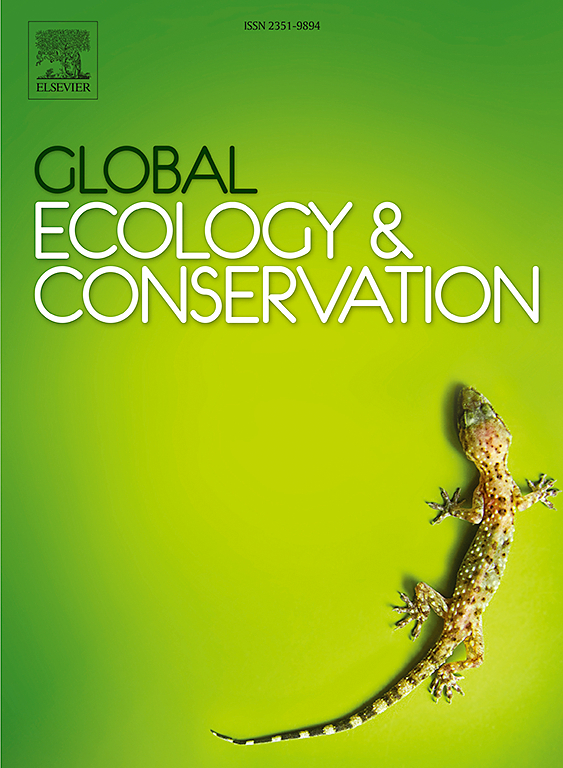Prioritising the conservation of benthic, sedentary, and invertivorous fish species in the East China Sea: Insights from multidimensional rarity
IF 3.5
2区 环境科学与生态学
Q1 BIODIVERSITY CONSERVATION
引用次数: 0
Abstract
Rare species are a crucial component of global biodiversity, contribute disproportionately to ecosystem functions and services, and represent a key target for conservation policies. Examining species rarity across multiple dimensions (taxonomic, functional, and phylogenetic) can offer deeper insights into biodiversity patterns. Using seven years of bottom trawl survey data, along with fish trait and mitochondrial gene information, this study quantified rarity indices for 242 fish species in the central East China Sea, including taxonomic, functional, and phylogenetic rarity, as well as species restrictedness. Differences in rarity among fish with different traits were assessed, and the relationships between the various rarity indices were explored using generalized additive models. Finally, taxonomically, functionally and phylogenetically rare species were identified. The results showed that the taxonomic, functional, and phylogenetic rarity of benthic species was significantly higher compared to benthopelagic and pelagic species. Sedentary species exhibited the highest levels of taxonomic, functional, and phylogenetic rarity, while mobile species showed the lowest levels of multidimensional rarity. Invertivorous species displayed higher taxonomic and functional rarity, as well as species restrictedness, compared to herbivorous-invertivorous and invertivorous-piscivorous species. Correlations between different rarity indices were very weak. A total of 34 taxonomically rare species, 18 functionally rare species, and 14 phylogenetically rare species were identified, with five species being rare across all three dimensions. Our findings emphasise that, in addition to prioritising taxonomically, functionally, and phylogenetically rare species in conservation, future coastal fish conservation and management efforts should also enhance protection for benthic, sedentary, and invertivorous species.
优先保护东海底栖、定居和无性鱼类:来自多维稀有度的见解
稀有物种是全球生物多样性的重要组成部分,对生态系统功能和服务的贡献不成比例,是保护政策的关键目标。从多个维度(分类、功能和系统发育)检查物种的稀有性可以更深入地了解生物多样性模式。利用7年的海底拖网调查资料,结合鱼类性状和线粒体基因信息,定量分析了东海中部242种鱼类的稀有度指标,包括分类稀有度、功能稀有度、系统发育稀有度和物种限制度。利用广义加性模型分析了不同性状鱼类间的稀有度差异,并探讨了各稀有度指标之间的关系。最后,在分类上、功能上和系统发育上鉴定出稀有种。结果表明,底栖物种在分类、功能和系统发育上的稀有性明显高于底栖和远洋物种。定居物种在分类、功能和系统发育上的罕见度最高,而流动物种在多维度上的罕见度最低。与食草-反食性和反食性-鱼食性物种相比,反食性物种在分类和功能上表现出更高的稀有性和物种限制性。不同稀有度指数之间的相关性非常弱。共鉴定出分类珍稀种34种,功能珍稀种18种,系统发育珍稀种14种,其中5种在3个维度上均为珍稀种。我们的研究结果强调,除了在分类、功能和系统发育上优先保护稀有物种外,未来的沿海鱼类保护和管理工作还应加强对底栖、定居和无食性物种的保护。
本文章由计算机程序翻译,如有差异,请以英文原文为准。
求助全文
约1分钟内获得全文
求助全文
来源期刊

Global Ecology and Conservation
Agricultural and Biological Sciences-Ecology, Evolution, Behavior and Systematics
CiteScore
8.10
自引率
5.00%
发文量
346
审稿时长
83 days
期刊介绍:
Global Ecology and Conservation is a peer-reviewed, open-access journal covering all sub-disciplines of ecological and conservation science: from theory to practice, from molecules to ecosystems, from regional to global. The fields covered include: organismal, population, community, and ecosystem ecology; physiological, evolutionary, and behavioral ecology; and conservation science.
 求助内容:
求助内容: 应助结果提醒方式:
应助结果提醒方式:


